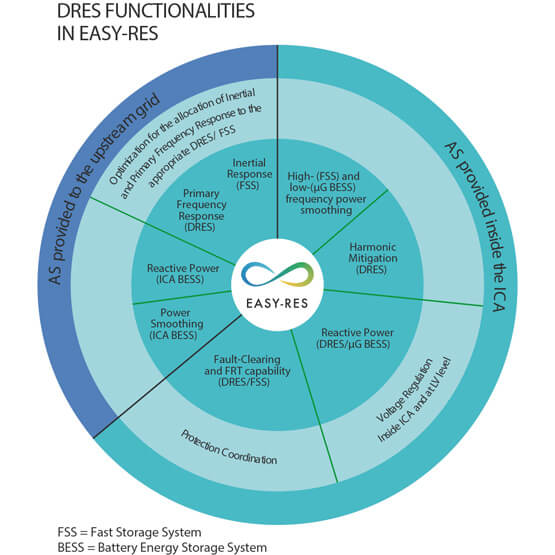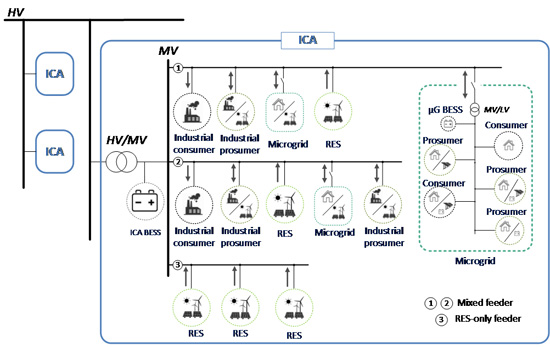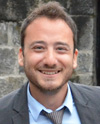Enable Ancillary Services bY Renewable Energy Sources (EASY-RES Project)
By C. S. Demoulias, K.-N. D. Malamaki, G. C. Kryonidis, M. Cvetkovic, U. Mushtaq, S. I. Gkavanoudis, K. O. Oureilidis, J. M. Mauricio, and E. O. Kontis
The increasing penetration of Distributed Renewable Energy Sources (DRES) has brought into focus a series of technical problems that jeopardize the stable and reliable operation of electrical power systems. EASY-RES is an EU Horizon 2020 research project aiming to the improvement of the energy security by making DRES provide a number of significant new Ancillary Services (AS) allowing, thus, high DRES penetration -up to 100%- in the grid with simultaneous decommission of large Synchronous Generators (SGs) driven by fossil-fuels.
Gaps, Opportunities, and Drivers

The stability and security of the traditional electrical power systems is largely based on the inherent properties of SGs: (i) inertia due to their rotating masses; (ii) power oscillations damping due to rotor’s damper coils; (iii) grid-forming capability; (iv) reactive power capability; (v) provision of large currents, when suddenly short-circuited. These properties formed the basis for the design of the current grid network topologies and fault-protection systems.
The growing penetration of converter-interfaced, inertia-less DRES tends to gradually replace dispatchable SGs. This, in addition to the intermittent nature of DRES (e.g. solar, wind) and their dispersion across the distribution grid, leads to increased power volatility and bi-directional power flows. The latter in turn have caused several problems: large frequency deviations, voltage regulation issues, power quality problems and fault detection/clearing issues.
Currently, typical measures to avert these issues include: increase of SG spinning reserves, grid reinforcement at various voltage levels and increased use of central electric Energy Storage Systems (ESS). However, due to their centralized approach and high cost, these actions can be undertaken only by Transmission System Operators (TSOs) and Distribution System Operators (DSOs), leaving the grid-supporting potential of DRES untapped. Yet, it is questionable if the capital and operational costs of these methods can be allocated in a fair and transparent way to the electricity stakeholders.
For all these reasons, DRES must urgently adopt a new more active role in the electricity networks. A similar active role could also be adopted by microgrids (μGs) at LV distribution grids. New AS can be provided to the DSOs and TSOs by the individual DRES and μGs in a coordinated control scheme.
Technological Innovation/Potential
The term “ancillary service” is frequently used in the technical literature to describe various functionalities of the DRES, e.g. reactive power for voltage regulation purposes, virtual inertia, primary frequency control (PFC), harmonic mitigation or even power smoothing. However, there is no established method for the simultaneous provision of these AS in a unified way by a common hardware and control algorithm. Moreover, there is still no agreed method to quantify and measure these AS. The latter is important to enable AS that are offered at the distribution system to participate in future AS markets.
In EASY-RES the following bottom-up approach is adopted:
(i) Every DRES, especially the converter-interfaced ones, will be able to offer several AS: virtual inertia, PFC, reactive power for voltage regulation, controllable contribution of currents during faults, mitigation of voltage harmonic pollution and active power smoothing. Properly and reasonably sized Fast Storage Systems (FSS), e.g. ultracapacitors, together with new control algorithms will be employed for this reason.
(ii) Methods to quantify and measure the AS offered by each DRES will be developed. From the hardware point of view, only the FSS bank and the associated DC/DC converter will be additionally needed, while the main DRES DC/AC converter may remain at its current topology, apart from a slight oversizing. On the other hand, the control algorithm is quite innovative addressing simultaneously the main DRES converter and the FSS bank, so that the DRES is seen from the grid as a virtual SG with new enhanced functionalities, that are fully controllable and quantifiable, contrary to conventional SGs.
(iii) At distribution system level, one or more Individual Control Areas (ICAs) are foreseen, where the DRES with the new functionalities are optimally orchestrated by the DSO via suitably designed ICT infrastructure for: voltage regulation, protection coordination, optimal allocation of virtual inertia and PFC and coordinated harmonic mitigation inside the ICA. In case of ICT failure or emergencies, the coordination will continue through decentralized algorithms, but not in an optimal way.

(iv) Based on the ICA topology, the type and location of the DRES, the forecasted RES and load magnitude, and the controllability of the DRES, the DSO will be able to offer quantified inertial and PFC to the upstream TSO at the ICA Point of Common Coupling together with the associated cost of these AS. In other words, the ICA will be seen by the TSO as active virtual power plant with predictable frequency dynamics. The proper definition and quantification of every AS will enable the per-unit estimation of the investment and operational cost for the provision of each AS, either individually or in aggregated form, leading in this way, to a proper remuneration within the frame of existing or new AS markets at the ICA level.
Implementation
In the EASY-RES approach, the DSO is able to control each individual DRES and provide AS in an aggregated form either within the ICA or to the upstream TSO. At the ICA level, the provision of the AS by DRES and ESS are optimally coordinated by Central Controllers at LV and MV level. These coordinated algorithms obey technical constraints posed by the DSO (e.g. thermal limits, overvoltage, total harmonic distortion, power and energy losses, etc.) considering the DRES type and location inside the ICA.
Since the DRES will offer controllable inertia and PFC, a methodology is introduced for the evaluation -at given future time interval – of the amount/cost of inertial response and PFC offered by the DSO to the upstream TSO. The cost is also a variable, because it depends on the aforementioned technical constraints and parameters.
Another tool will enable the DSO to develop the equivalent dynamic model of each ICA and pass it to the TSO for enhanced stability analysis.
To enable the proper remuneration of the AS, EASY-RES will develop basic business models based on detailed cost-functions per AS and on the estimation of the investments that are deferred when the new AS are offered by the DRES. Such investments are e.g. line reinforcements, protection system upgrades, use of capacitor or coil banks, reduction of conventional reserves, etc.
So far, suitable metrics have been developed for the proper measurement and quantification of the required AS. Moreover, expressions have been derived to evaluate the DRES converter losses due to reactive power exchange and a new voltage control scheme for MV networks has been proposed in recent scientific publications in the frame of EASY-RES.
Anticipated Impact
EASY-RES is expected to improve energy security by allowing very high RES penetration (up to 100%) in the grid with simultaneous decommission of large SG driven by fossil fuels. This is expected to have a great impact on the environment and will contribute to solving the global climate and energy challenges.
The high RES penetration will be demonstrated through the following technical goals:
- The average overall system inertia will be increased by at least 1.5% for every 10% increase in DRES penetration due to the DRES controllable inertia.
- For every 3 MW of DRES integrated into the system, more than 2.5 MW of conventional reserves will be decommitted.
- The extended DRES reactive power capability and the new controllable contribution to fault-clearing process are expected to make the ICA autonomous with respect to voltage regulation and protection coordination, while avoiding additional investments in grid reinforcement and new protection systems.
EASY-RES is expected to have economic impacts in the energy policy and markets, as well. The new metrics will enable the development of (i) viable business models between DSO/TSO; (ii) new AS markets within the ICAs in which DRES owners, including the small ones, can participate either alone or in aggregated communities.

Charis S. Demoulias (M’96, SM’11) received the Diploma and Ph.D. degrees in Electrical Engineering from the Aristotle University of Thessaloniki, Thessaloniki, Greece, in 1984 and 1991, respectively. He worked for 12 years as consultant to industries on issues related to energy savings, power quality and renewable energy sources (RES). Currently, he is Associate Professor with the Electrical Machines Laboratory, Department of Electrical and Computer Engineering, Aristotle University of Thessaloniki. His research interests are in the fields of power quality, power electronics, renewable energy sources (RES) and integration of RES into the power grid. He is the coordinator of EASY-RES, a project funded by European Union.

Kyriaki-Nefeli D. Malamaki received her Diploma in Electrical and Computer Engineering from the Aristotle University in 2012. She is currently a Ph.D. student with the Electrical and Computer Engineering Department of the Aristotle University of Thessaloniki, Greece. Her research interests are in the fields of power quality and efficiency, interface of renewable energy sources with the grid and power electronic converters.

Georgios C. Kryonidis received his Diploma and PhD degrees in Electrical and Computer Engineering from Aristotle University of Thessaloniki in 2013 and 2018, respectively. Currently, he is a Post-Doctoral Researcher at the same University and an adjunct Lecturer at the Department of Electrical Engineering of Western Macedonia University of Applied Sciences. His research interests include distributed generation and storage, renewable energy sources, and smart grids operation and control. He was a scholar of the Research Committee of the Aristotle University of Thessaloniki (2016-2017) and of the Greek State Scholarships Foundation (2017-2018). Finally, he is a member of IEEE and of the Technical Chamber of Greece.

Miloš Cvetković is an Assistant Professor with the Electrical Sustainable Energy department at Delft University of Technology, Netherlands. He received the B.Sc. degree in electrical engineering from the University of Belgrade in Serbia in 2008, and the M.Sc. and Ph.D. degrees in electrical and computer engineering from Carnegie Mellon University, Pittsburgh, PA, USA, in 2011 and 2013, respectively. For a period of time, he worked as a postdoctoral researcher in the Active-Adaptive Control Laboratory at MIT. His research interests include development of co-simulations for energy grids and modeling for control and optimization of the electricity grids.

Umer Mushtaq is a Ph.D. candidate at the Delft University of Technology, Netherlands. His research interests include energy storage, renewable generation, and ancillary services. He received B.Sc. degree in Electrical and Electronic Engineering from the University of Engineering and Technology Lahore, Pakistan. He was awarded an Erasmus Mundus joint Master Degree Scholarship from EACEA European Union. He has a master degree in Sustainable Transportation and Electrical Power Systems from the University of Oviedo Spain (Program Coordinator), the Polytechnic Institute of Coimbra Portugal and the University of Nottingham UK.

Spyros Gkavanoudis was born in Larissa, Greece, in 1983. He received the diploma degree in electrical and computer engineering from the Aristotle University of Thessaloniki, Greece, in 2008, and the Ph.D degree in power electronics from the same university under the mentorship of Dr. Charis Demoulias, in 2014. Currently, he is a post-doctoral researcher in the department of Electrical and Computer Engineering at Aristotle University of Thessaloniki. His primary research activities lie in the fields of power electronic converters, wind energy conversion systems, modeling and contol of electrcal machines, microgrids and energy storage systems. In particular, his research focuses on the design of dedicated power and control systems for wind turbine generators. His doctoral dissertation discussed the integration of supercapacitor energy storage systems in inverter-interfaced wind turbine generators, in order to enhance their fault ride-through capability, as well as to improve wind power quality. Since 2008 he has been with the Electrical Machines Laboratory, Department of Electrical and Computer Engineering, Aristotle University of Thessaloniki as a Research Assistant. He served as a teaching assistant the undergraduate courses of Electrical Machines (II & III), Power Electronics (I & II) and Electric Motion Systems.

Dr. Konstantinos O. Oureilidis was born in Alexnadroupolis, Greece, in 1984. He received his Diploma (2008) and PhD degrees (2015) in Electrical and Computer Engineering from Aristotle University of Thessaloniki and his Bachelor degree in Business Administration from University of Macedonia, Thessaloniki (2015). In 2016-2017, he worked as adjunct lecturer for the course of Electric Motion Systems and lab assistant for the course of Power Electronics. From 2015, he is a post-doc researcher with the Department of Electrical and Computer Engineering, Aristotle University of Thessaloniki and he received a funding from IKY Fellowships of Excellence (Siemens Program for conducting post-doc research). From 2017 he works as a special scientist at Hellenic Energy Exchanges (HEnEx S.A.). His fields of interest include the microgrids, control of power electronics, distributed generation, renewable energy sources and protection. He is Member of IEEE and Member of the Technical Chamber of Greece.

Juan Manuel Mauricio was born in Argentina in 1977. He received the degree in electrical engineering from the National University of Comahue, Neuquen, Argentina, in 2003, and the Master’s and Dr. Eng. degrees from the University of Seville, Seville, Spain, in 2007 and 2009, respectively. Since 2004, he has been with the Department of Electrical Engineering, University of Seville, where he is currently an Assistant Professor. His primary research interests include power systems and electrical machine control, renewable generation, voltage source converters-based applications, and electrical vehicles.

Eleftherios O. Kontis (S’15-M’19) received the Dipl. Eng. and Ph.D. degrees from the School of Electrical and Computer Engineering at the Aristotle University of Thessaloniki, Greece, in 2013 and 2018, respectively. He is currently Post-Doc researcher at the Power Systems Laboratory of the School of Electrical and Computer Engineering of the Aristotle University of Thessaloniki. His research interests are in the field of power system modeling, simulation and dynamic analysis of active distribution networks and smart grids. He has been a scholar of the Greek State Scholarships Foundation (2017 – 2018).
To have the Bulletin delivered monthly to your inbox, join the IEEE Smart Grid Community.
Past Issues
To view archived articles, and issues, which deliver rich insight into the forces shaping the future of the smart grid. Older Bulletins (formerly eNewsletter) can be found here. To download full issues, visit the publications section of the IEEE Smart Grid Resource Center.




